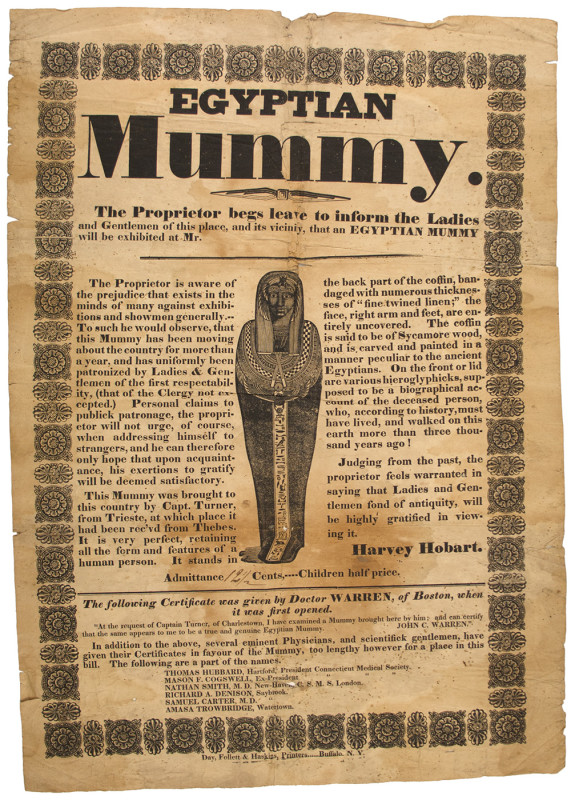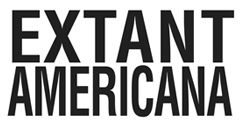
(Egyptomania) Broadside, “EGYPTIAN Mummy. The Proprietor begs leave to inform the Ladies and Gentlemen of this place, and its vicinity, that an EGYPTIAN MUMMY will be exhibited at Mr…” 1p., 475 x 335 mm. (18 3/4 x 13 1/4 in.), (Buffalo: Day, Follett & Haskins, Printers, [c. 1830])1.
A superb illustrated broadside featuring an Egyptian sarcophagus at center and a lengthy explanation by Harvey Hobart: “the Proprietor is aware of the prejudice that exists in the minds against exhibitions and showmen generally. — To such he would observe, that this Mummy has been moving about the country for more than a year, and has uniformly been patronized by Ladies & Gentlemen of the first respectability, (that of the Clergy not excepted).” Hobart explained that the mummy “was brought to his country by Capt. Turner, from Trieste, at which place it had been rec’vd from Thebes…. The coffin is said to be of Sycamore wood, and is carved and painted in a manner peculiar to ancient Egyptians… the decease person… according to history, must have lived, and walked on this earth more than three thousand years ago!”
Like other showmen, Hobart was caught up in “Egyptomania” that swept the nation in the 1820s and 1830s, and this was one of several mummies touring the country at the time.2 Napoleon’s Egyptian campaign at the end of the 18th century reignited Western interest in the region and its ancient culture resulting in an explosion of archeology and scholarship. European travelers returning from Egypt brought with them numerous artifacts including complete mummies. Interest in ancient Egypt was acute in the Untied States where it strongly influenced architecture, decorative arts and literature. Mummies arose particular interest, not only among curiosity-seekers, but by medical professionals who saw the preserved corpses as objects of study for the field of craniology, which purported to determine intelligence and race based on skull size and shape.
To substantiate his claim that the mummy was genuine, Hobart quotes a certificate issued by the eminent Boston surgeon, Dr. Joseph Collins Warren (1778-1856): “At the request of Captain Turner, of Charlestown, I have examined a Mummy brought here by him; and can certify that the same appears to be me to be a true and genuine Egyptian Mummy.”3. Hobart also claims the endorsements of several other eminent New England physicians including Thomas Hubbard, the President of the Connecticut Medical Society.
Extremely Rare. Not listed in American Broadsides and Ephemera, Series I. OCLC lists no extant editions in institutional holdings.
Expected folds, toned with some moderate soiling, marginal tears, else very good overall.
(EXA 5347) SOLD.
________________
1 Day, Follett & Haskins were active in Buffalo from c. 1820-1839, Source. OCLC.
2 Middlesex Gazette (Middletown, Conn.), 24 Apr. 1827, 3: “A gentleman is now exhibiting, in this city [Boston], an Egyptian Mummy. He has a certificate from Dr. Warren of Boston, who states his belief that it is genuine.” (We not certain if this is the same mummy as Hobart’s) ; also “A Mummy”, Farmer’s Cabinet (Amherst, N.H.) 10 May 1823, 2.
3 In 1846, Warren staged the first public demonstration of the use of ether as a general anesthetic. He was the nephew of Dr. Joseph Warren, killed at Bunker Hill.
